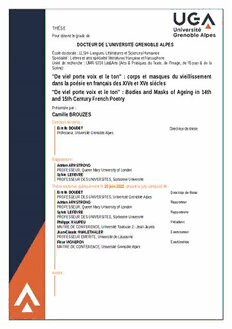
"De viel porte voix et le ton" : corps et masques du vieillissement dans la poésie en français des XIVe et XVe siècles PDF
534 Pages·2022·3.368 MB·French
Most books are stored in the elastic cloud where traffic is expensive. For this reason, we have a limit on daily download.
Preview "De viel porte voix et le ton" : corps et masques du vieillissement dans la poésie en français des XIVe et XVe siècles
Description:
This dissertation focuses on the representations of aging in Late-Medieval French poetry. Through comparative readings of the works of a dozen poets, including Eustache Deschamps, Charles d’Orléans, Michault Taillevent or Jean Froissart, it analyzes the reasons why poetry during this period became the main locus for the exhibition of senescent bodies, and more particularly of old men’s self-portraits. We show how the incursion of old age into a literary genre hitherto dedicated to the representation of youth contributes to the mutation of the poetic voice in literary history. We start from the assumption that the mask of old age contains interesting resources for the poets who seek to assert a superiority, even if they present it as a position of weakness. The first part focuses on the aging body that poets give themselves, showing how they reconfigure the knowledge at their disposal, which strongly frames the medieval conception of senescence, to produce a poetic body marked by singularity, even in its most obscene dimension. The second part deals with the relationship between these male bodies and a feminine old age to which they give voice. While perpetuating a tradition of highly misogynistic portrayals of women’s senescence, poets also let us hear female voices in a less comical way. By making old women the bearers of their aesthetics, they confer dignity on them through poetic incarnation. The last part intends to redefine the aesthetic and communicational implications of the senescent’s poetic identity. We establish that senescence holds a special position among the different masks that poets may adopt. If it is not always biographically anchored, this mask is defined in relation to a morality of the ages which imposes duties and offers benefits, bringing at the heart of the texts a stronger affective charge intended to touch the readership. The advantages of a senescent ethos appear more clearly when examining two types of communicational acts: teaching and its didactic discourse and requesting, by which poets put forward a demand. Our study thus challenges the negativity that the field of aging studies associates with the notion of stereotype: used by senescent poets, stereotypes become an asset rather than a constraint.
See more
The list of books you might like
Most books are stored in the elastic cloud where traffic is expensive. For this reason, we have a limit on daily download.
